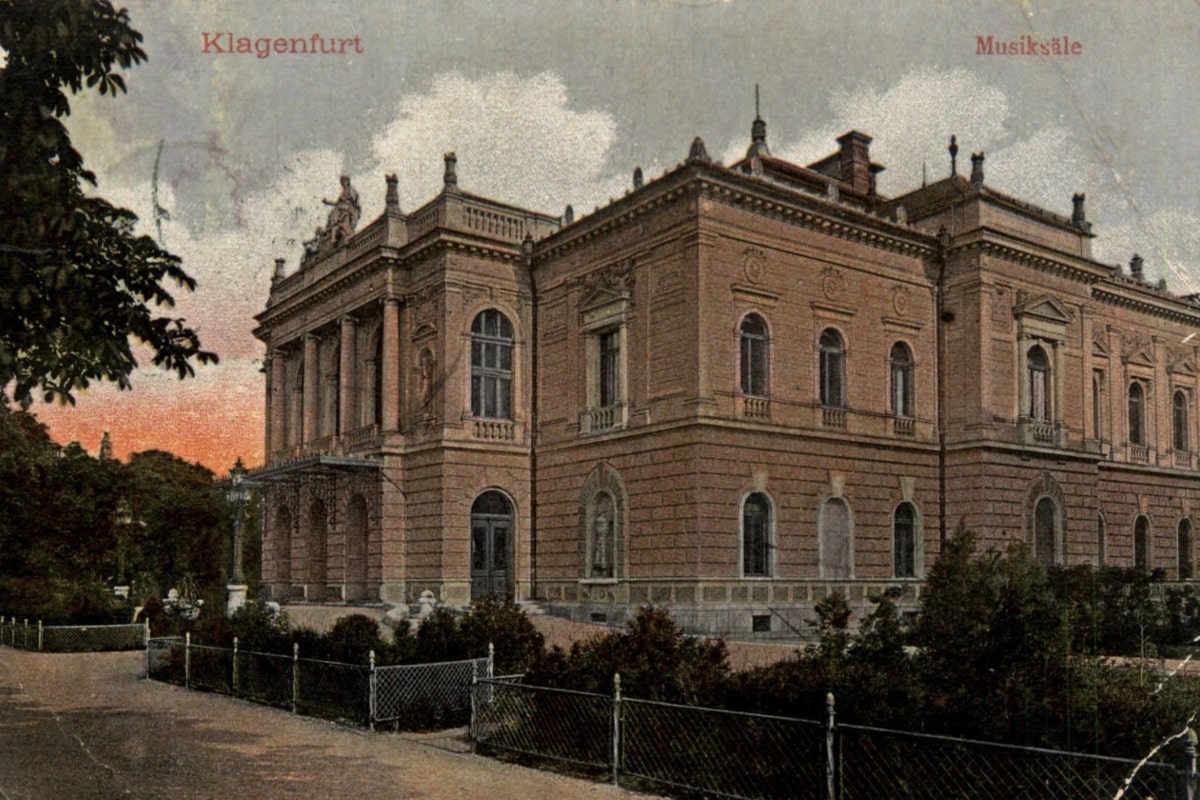
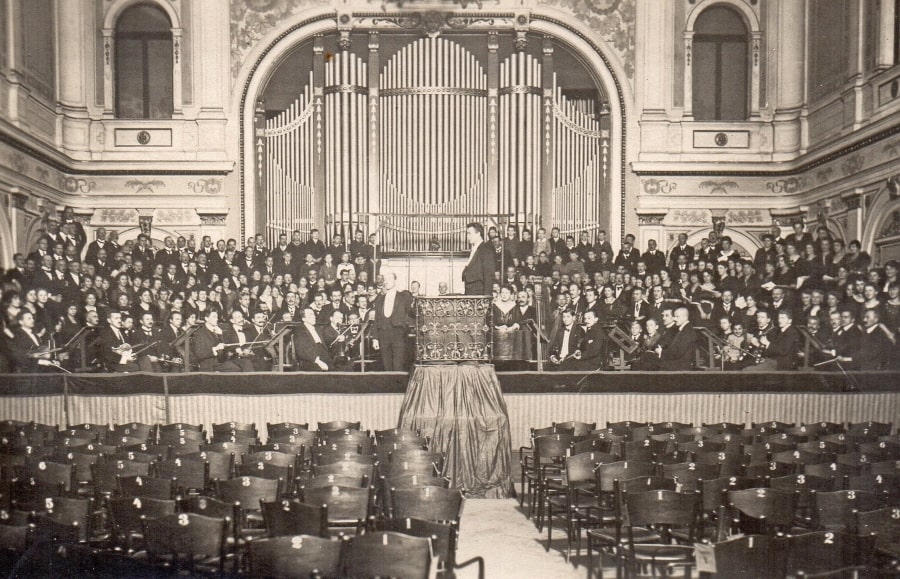
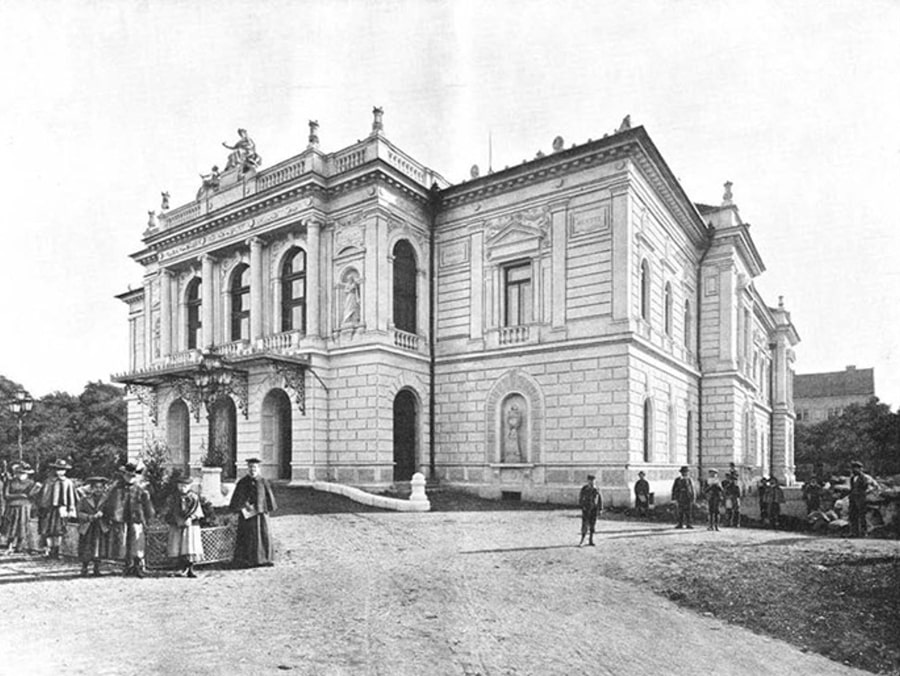
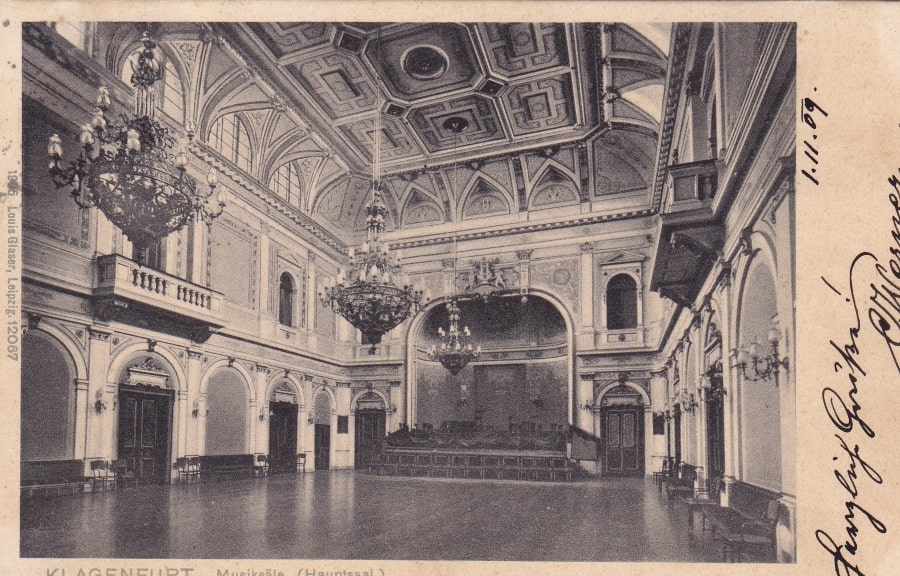
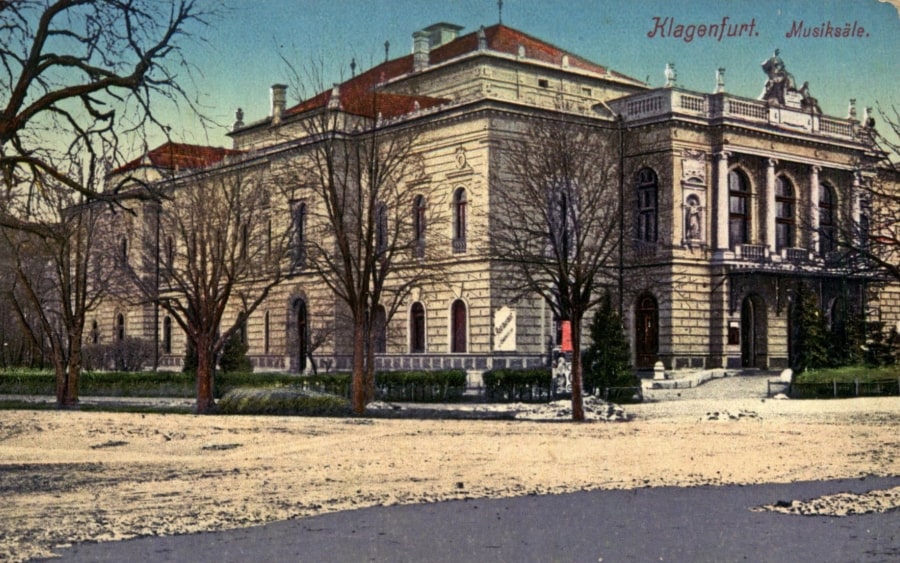


An auditorium is a room built to enable an audience to hear and watch performances. For movie theatres, the number of auditoria (or auditoriums) is expressed as the number of screens. Auditoria can be found in entertainment venues, community halls, and theaters, and may be used for rehearsal, presentation, performing arts productions, or as a learning space.


An avant-corps, a French term literally meaning "fore-body", is a part of a building, such as a porch or pavilion, that juts out from the corps de logis, often taller than other parts of the building. It is common in façades in French Baroque architecture.


An awning or overhang is a secondary covering attached to the exterior wall of a building. It is typically composed of canvas woven of acrylic, cotton or polyester yarn, or vinyl laminated to polyester fabric that is stretched tightly over a light structure of aluminium, iron or steel, possibly wood or transparent material.


Balconet or balconette is an architectural term to describe a false balcony, or railing at the outer plane of a window-opening reaching to the floor, and having, when the window is open, the appearance of a balcony.


A baluster is a vertical moulded shaft, square, or lathe-turned form found in stairways, parapets, and other architectural features. In furniture construction it is known as a spindle. Common materials used in its construction are wood, stone, and less frequently metal and ceramic. A group of balusters supporting a handrail, coping, or ornamental detail are known as a balustrade.


A bossage is an uncut stone that is laid in place in a building, projecting outward from the building. This uncut stone is either for an ornamental purpose, creating a play of shadow and light, or for a defensive purpose, making the wall less vulnerable to attacks.


In architecture the capital (from the Latin caput, or "head") or chapiter forms the topmost member of a column (or a pilaster). It mediates between the column and the load thrusting down upon it, broadening the area of the column's supporting surface. The capital, projecting on each side as it rises to support the abacus, joins the usually square abacus and the usually circular shaft of the column.


A cartouche (also cartouch) is an oval or oblong design with a slightly convex surface, typically edged with ornamental scrollwork. It is used to hold a painted or low-relief design. Since the early 16th century, the cartouche is a scrolling frame device, derived originally from Italian cartuccia. Such cartouches are characteristically stretched, pierced and scrolling.


In architecture, a cornice (from the Italian cornice meaning "ledge") is generally any horizontal decorative moulding that crowns a building or furniture element - the cornice over a door or window, for instance, or the cornice around the top edge of a pedestal or along the top of an interior wall.


A dentil is a small block used as a repeating ornament in the bedmould of a cornice. Dentils are found in ancient Greek and Roman architecture, and also in later styles such as Neoclassical, Federal, Georgian Revival, Greek Revival, Renaissance Revival, Second Empire, and Beaux-Arts architecture.


A festoon, (originally a festal garland, Latin festum, feast) is a wreath or garland hanging from two points, and in architecture typically a carved ornament depicting conventional arrangement of flowers, foliage or fruit bound together and suspended by ribbons. The motif is sometimes known as a swag when depicting fabric or linen.


A finial or hip knob is an element marking the top or end of some object, often formed to be a decorative feature. In architecture, it is a small decorative device, employed to emphasize the apex of a dome, spire, tower, roof, gable, or any of various distinctive ornaments at the top, end, or corner of a building or structure.


A keystone is a wedge-shaped stone at the apex of a masonry arch or typically a round-shaped one at the apex of a vault. In both cases it is the final piece placed during construction and locks all the stones into position, allowing the arch or vault to bear weight. In arches and vaults, keystones are often enlarged beyond the structural requirements and decorated. A variant in domes and crowning vaults is a lantern.


A niche is a recess in the thickness of a wall. By installing a niche, the wall surface will be deeper than the rest of the wall over a certain height and width. A niche is often rectangular in shape, sometimes a niche is closed at the top with an arch, such as the round-arched friezes in a pilaster strip decoration. Niches often have a special function such as an apse or choir niche that houses an altar, or a tomb.


The palmette is a motif in decorative art which, in its most characteristic expression, resembles the fan-shaped leaves of a palm tree. It has a far-reaching history, originating in ancient Egypt with a subsequent development through the art of most of Eurasia, often in forms that bear relatively little resemblance to the original. In ancient Greek and Roman uses it is also known as the anthemion. It is found in most artistic media, but especially as an architectural ornament, whether carved or painted, and painted on ceramics.


A pediment is an architectural element found particularly in Classical, Neoclassical and Baroque architecture, and its derivatives, consisting of a gable, usually of a triangular shape, placed above the horizontal structure of the lintel, or entablature, if supported by columns. The tympanum, the triangular area within the pediment, is often decorated with relief sculpture. A pediment is sometimes the top element of a portico. For symmetric designs, it provides a center point and is often used to add grandness to entrances.


In classical architecture, a pilaster is an architectural element used to give the appearance of a supporting column and to articulate an extent of wall, with only an ornamental function. It consists of a flat surface raised from the main wall surface, usually treated as though it were a column, with a capital at the top, plinth (base) at the bottom, and the various other column elements.


Quoins are masonry blocks at the corner of a wall. Some are structural, providing strength for a wall made with inferior stone or rubble, while others merely add aesthetic detail to a corner.


A spandrel is a roughly triangular space, usually found in pairs, between the top of an arch and a rectangular frame; between the tops of two adjacent arches or one of the four spaces between a circle within a square. They are frequently filled with decorative elements.


Graz is the capital city of the Austrian state of Styria and the second-largest city in Austria after Vienna. Graz is known as a college and university city, with four colleges and four universities. Its historic centre is one of the best-preserved city centres in Central Europe. In 1999, the city's historic centre was added to the UNESCO list of World Heritage Sites and in 2010 the designation was expanded to include Eggenberg Palace on the western edge of the city. The oldest settlement on the ground of the modern city of Graz dates back to the Copper Age. However, no historical continuity exists of a settlement before the Middle Ages.


Vienna is the national capital, largest city, and one of nine states of Austria. Vienna is Austria's most populous city, and its cultural, economic, and political center. Vienna's ancestral roots lie in early Celtic and Roman settlements that transformed into a Medieval and Baroque city. It is well known for having played a pivotal role as a leading European music center, from the age of Viennese Classicism through the early part of the 20th century. The historic center of Vienna is rich in architectural ensembles, including Baroque palaces and gardens, and the late-19th-century Ringstraße lined with grand buildings, monuments and parks.


Apollo is one of the Olympian deities in classical Greek and Roman religion and Greek and Roman mythology. The national divinity of the Greeks, Apollo has been recognized as a god of archery, music and dance, truth and prophecy, healing and diseases, the Sun and light, poetry, and more. One of the most important and complex of the Greek gods, he is the son of Zeus and Leto, and the twin brother of Artemis, goddess of the hunt. Seen as the most beautiful god and the ideal of the kouros, Apollo is considered to be the most Greek of all the gods. Apollo is known in Greek-influenced Etruscan mythology as Apulu.


In ancient Greek religion and mythology, the Muses are the inspirational goddesses of literature, science, and the arts. They were considered the source of the knowledge embodied in the poetry, lyric songs, and myths that were related orally for centuries in ancient Greek culture. Melete, Aoede, and Mneme are the original Boeotian Muses, and Calliope, Clio, Erato, Euterpe, Melpomene, Polyhymnia, Terpsichore, Thalia, and Urania are the nine Olympian Muses. In modern figurative usage, a Muse may be a source of artistic inspiration.


The Anschluss, also known as the Anschluß Österreichs, was the annexation of the Federal State of Austria into the German Reich on 13 March 1938. The idea of an Anschluss (a united Austria and Germany that would form a "Greater Germany") began after the unification of Germany excluded Austria and the German Austrians from the Prussian-dominated German Empire in 1871. Following the end of World War I with the fall of the Austro-Hungarian Empire, in 1918, the newly formed Republic of German-Austria attempted to form a union with Germany, but the Treaty of Saint Germain (10 September 1919) and the Treaty of Versailles (28 June 1919) forbade both the union and the continued use of the name "German-Austria" and stripped Austria of some of its territories, such as the Sudetenland.


The Second World War was a global war that involved fighting in most of the world. Most countries fought from 1939 to 1945, but some started fighting in 1937. Most of the world's countries, including all of the great powers, fought as part of two military alliances: the Allies and the Axis Powers. It involved more countries, cost more money, involved more people, and killed more people than any other war in history. Between 50 to 85 million people died, most of whom were civilians. The war included massacres, a genocide called the Holocaust, strategic bombing, starvation, disease, and the only use of nuclear weapons against civilians in history.

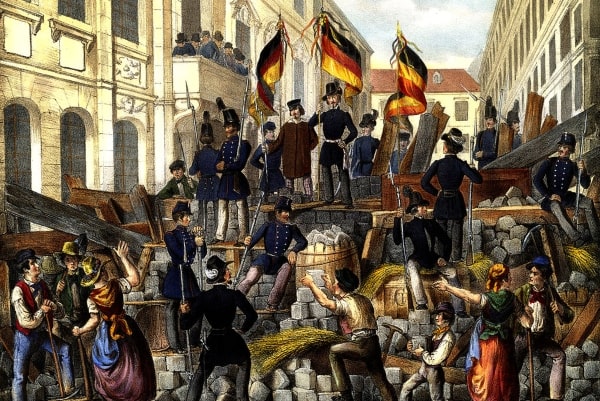
The Revolutions of 1848 in the Austrian Empire were a set of revolutions that took place in the Austrian Empire from March 1848 to November 1849. Much of the revolutionary activity had a nationalist character: the Empire, ruled from Vienna, included ethnic Germans, Hungarians, Slovenes, Poles, Czechs, Slovaks, Ruthenians (Ukrainians), Romanians, Croats, Venetians, and Serbs; all of whom attempted in the course of the revolution to either achieve autonomy, independence, or even hegemony over other nationalities. The nationalist picture was further complicated by the simultaneous events in the German states, which moved toward greater German national unity. Besides these nationalists, liberal, and even socialist currents resisted the Empire's longstanding conservatism.

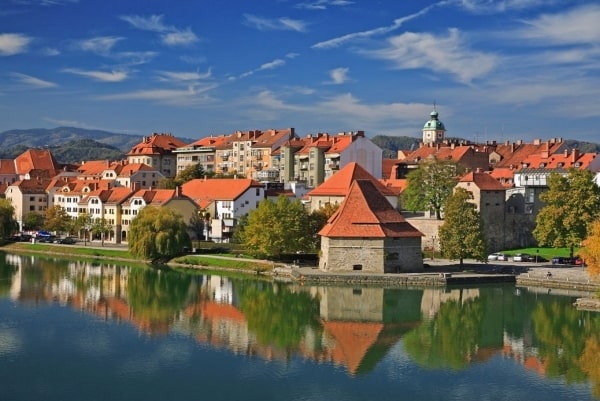
Maribor is the second-largest city in Slovenia and the largest city in the traditional region of Lower Styria. It is also the seat of the City Municipality of Maribor, the seat of the Drava Statistical Region, and the Eastern Slovenia region. Maribor is also the economic, administrative, educational, and cultural center of eastern Slovenia. Maribor was first mentioned as a castle in 1164, as a settlement in 1209, and as a city in 1254. Like most Slovene ethnic territory, Maribor was under Habsburg rule until 1918, when Rudolf Maister and his men secured the city for the State of Slovenes, Croats and Serbs, which then joined the Kingdom of Serbia to form the Kingdom of Yugoslavia. In 1991 Maribor became part of independent Slovenia.

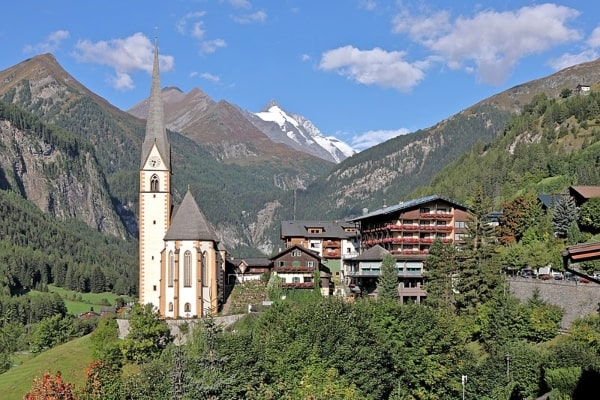
Carinthia is the southernmost Austrian state, in the Eastern Alps, and is noted for its mountains and lakes. The main language is German. Its regional dialects belong to the Southern Bavarian group. Carinthian Slovene dialects, forms of a South Slavic language that predominated in the southeastern part of the region up to the first half of the 20th century, are now spoken by a small minority in the area. Carinthia's main industries are tourism, electronics, engineering, forestry, and agriculture.

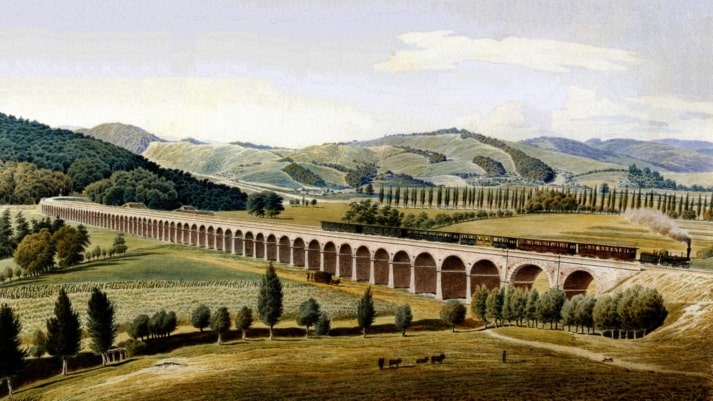
The Südbahn-Gesellschaft, literally South Railway Company, was an Austrian corporation that built and operated numerous railway lines in the Austrian Empire, Austria-Hungary after 1867, and for some time in Austria, Hungary, and the Kingdom of Yugoslavia after 1918. The company was notable for two reasons. First, the split-up of its assets after the end of the First World War took almost two decades. Second, the company existed even after ending all railway operations as an administration of assets, mainly for securing the pension claims of its former employees.

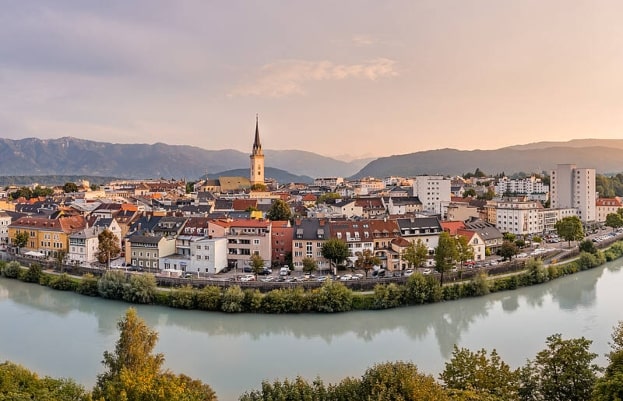
Villach is the seventh-largest city in Austria and the second-largest in the federal state of Carinthia. It is an important traffic junction for southern Austria and the whole Alpe-Adria region. The oldest human traces found in Villach date back to the late Neolithic. Many Roman artifacts have been discovered in the city and its vicinity, as it was near an important Roman road leading from Italy into the Noricum province established in 15 BC. Villach received market rights in 1060, though it was not mentioned as a town in records until about 1240. During the Napoleonic Wars, the city was occupied by French troops and became part of the short-lived Illyrian Provinces from 1809, until it was re-conquered by the forces of the Austrian Empire in 1813 and incorporated into the Austrian Kingdom of Illyria by 1816.

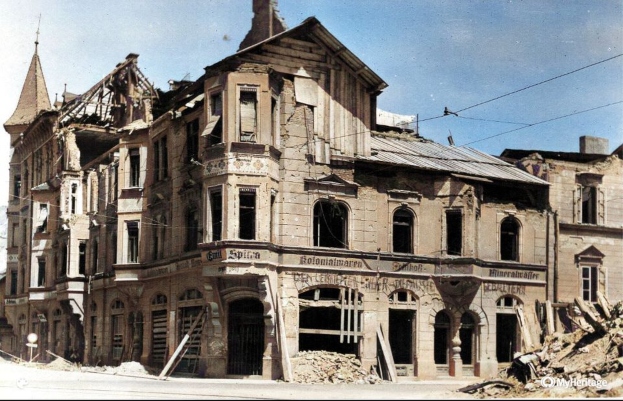
In September 1943, the first bombs fell on built-up urban areas on Sunday, January 16, 1944, at 11:41 a.m. The main targets were the area around the main train station and the tobacco factory on Kempfstrasse, where part of German aircraft production had been relocated from Wiener Neustadt to Klagenfurt. In three waves of attacks, 90 bombers dropped around 1,200 high-explosive bombs over the city. There were 234 deaths, 73 seriously injured, and around 1,800 homeless people. This attack was followed by 48 more by April 26, 1945, 12 of which were major attacks in which a total of 2,000 tons of bombs were dropped. At the end of the war, 3,413 houses and 9,672 apartments had been destroyed. 60 percent of Klagenfurt's apartments were destroyed and 510 people were killed. 1665 Klagenfurt residents died as soldiers during the war.

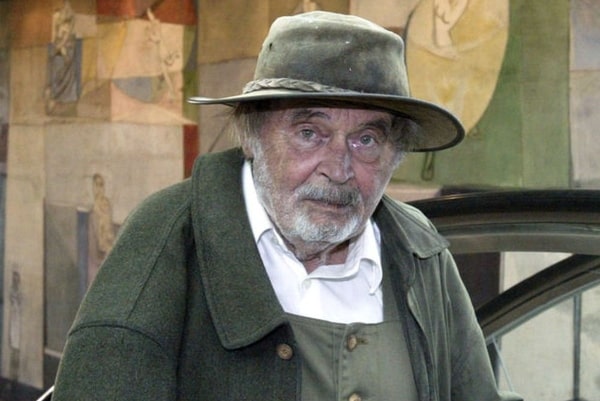
Giselbert Hoke (September 12, 1927 in Varnsdorf, Czechoslovakia - April 18, 2015 in Klagenfurt) was an Austrian artist. His areas of work were paintings in the form of frescoes, watercolors as well as lithographs and glass works. Hoke was born in Varnsdorf as the second of six children. He became interested in blacksmithing from an early age. However, during the Second World War, he lost his right arm when he was just 17 years old. After the war, he completed his high school diploma in Klagenfurt (Carinthia) in 1946 and went to study at the Academy of Fine Arts Vienna with Robin Christian Andersen and Herbert Boeckl. Listed wall fresco Wall of the Plaintiffs at Klagenfurt Central Station In 1950 he received first prize in the artistic competition for the design of the now-listed wall frescoes in the hall of the then-newly built Klagenfurt Central Station, each of which is 22 meters wide and 5 meters high. The east side Wall of the Plaintiffs and the west side Wall of the Defendants feature the formal language of Pablo Picasso. However, the population of Klagenfurt was not very impressed with modern art: after its completion in 1956, there were protests; The conservative citizens demanded the destruction of the work of art. Hoke retired to Vienna. Between 1953 and 1954 he lived and worked in Paris on a scholarship from the French state.

Leopold Theyer (October 14, 1851 in Vienna - July 7, 1937 in Graz) was an Austrian late historicist architect and craftsman Leopold Theyer grew up as the youngest son of a paper manufacturer with his three siblings in Vienna. After attending secondary school, he studied at the Technical University under Heinrich Ferstel from 1869 to 1873. He then studied architecture with Friedrich Schmidt at the Academy of Fine Arts (1873-1876). Through his training and his teachers, Theyer was a typical representative of late historicism, in particular, the Old German style. Many houses on Graz's Joanneumring were designed by Leopold Theyer when the Joanneum Gardens were built around the former Neutor. His student at the time, Jože Plečnik, was an employee. Theyer went on various study trips to Germany, Italy, France, England, Belgium, Sweden, Holland, and Russia. From 1877 to 1883 Theyer was a teacher of technical drawing at the Vienna Austrian Museum of Art and Industry, the forerunner institution of the University of Applied Arts. From 1884 to 1887 he was appointed director of the technical school for the wood industry in Bolzano. His career as a professor began in 1887 in Graz at the State Trade School, then continued from 1906 as an associate professor at the Graz University of Technology in the subject of 'technical drawing and freehand drawing' and finally from 1910 with a full professorship. From 1913 to 1923 he taught there as a teacher for structural engineering and reinforced concrete construction, and in the years 1910 to 1914 and 1917 to 1921 as dean. From 1890 onwards, Theyer was primarily responsible for the general plan for the development of the Joanneum Gardens between Neutorgasse, Kaiserfeldgasse, and Raubergasse in Graz. In the following years, the majority of the buildings here were built according to his plans. Numerous residential and commercial buildings were built along Joanneumring. Theyer was also a member of the art advisory board of the city building authority and a juror in architectural competitions. In addition to these activities, he designed numerous interior furnishings and objects such as book covers.
